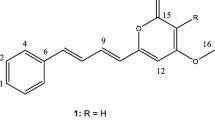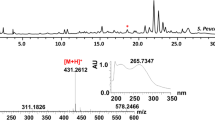Abstract
Antrodia cinnamomea, an endemic basidiomycete used as a health food in Taiwan, is known to synthesize antroquinonols, which were reported to have notable medicinal potential in oncology and immunology. However, the biosynthetic pathway of these compounds is currently unclear. Our previous study showed that a pks63787 knockout mutant of A. cinnamomea (∆pks63787) is deficient in the biosynthesis of several aromatic metabolites. In this study, we pointed by phylogenetic analysis that pks63787 likely encodes an orsellinic acid synthase. Moreover, amendment of the cultural medium with orsellinic acid not only restores the ability of ∆pks63787 to produce its major pigment and other deficient metabolites, e.g., antroquinonols, but also enhances the productivity of several antroquinonols, including two new compounds 2 and 3. These results provide direct evidence that the PKS63787 is involved in the biosynthesis of antroquinonols and confirmed our hypothesis that the 6-methylcyclohexenone moiety was synthesized via the PKS63787-mediated polyketide pathway. In conclusion, PKS63787 might function as orsellinic acid synthase and orsellinic acid is an important precursor indispensable for the biosynthesis of the major pigment and antroquinonols in A. cinnamomea. To facilitate further basic or applied study, a putative biosynthesis pathway map of antroquinonols is proposed.






Similar content being viewed by others
References
Ahuja M, Chiang Y-M, Chang S-L, Praseuth MB, Entwistle R, Sanchez JF, Lo H-C, Yeh H-H, Oakley BR, Wang CCC (2012) Illuminating the diversity of aromatic polyketide synthases in Aspergillus nidulans. J Am Chem Soc 134:8212–8221. doi:10.1021/ja3016395
Ao Z-H, Xu Z-H, Lu Z-M, Xu H-Y, Zhang X-M, Dou W-F (2009) Niuchangchih (Antrodia camphorata) and its potential in treating liver diseases. J Ethnopharmacol 121:194–212. doi:10.1016/j.jep.2008.10.039
Bode HB, Bethe B, Höfs R, Zeeck A (2002) Big effecays to explore nature’s chemical diversity. Chembiochem 3:619–627. doi:10.1002/1439-7633(20020703)3:7<619::AID-CBIC619>3.0.CO;2-9
Chang T-T, Chou W-N (1995) Antrodia cinnamomea sp. nov. on Cinnamomum kanehirai in Taiwan. Mycol Res 99:756–758. doi:10.1016/S0953-7562(09)80541-8
Chang T-C, Yeh C-T, Adebayo BO, Lin Y-C, Deng L, Rao YK, Huang C-C, Lee W-H, Wu ATH, Hsiao M, Wu C-H, Wang L-S, Tzeng Y-M (2015) 4-Acetylantroquinonol B inhibits colorectal cancer tumorigenesis and suppresses cancer stem-like phenotype. Toxicol Appl Pharmacol 288:258–268. doi:10.1016/j.taap.2015.07.025
Chiang C-C, Huang T-N, Lin Y-W, Chen K-H, Chiang B-H (2013) Enhancement of 4-acetylantroquinonol B production by supplementation of its precursor during submerged fermentation of Antrodia cinnamomea. J Agric Food Chem 61:9160–9165. doi:10.1021/jf402187q
Chiang H-C, Wu D-P, Cherng I-W, Ueng C-H (1995) A sesquiterpene lactone, phenyl and biphenyl compounds from Antrodia cinnamomea. Phytochemistry 39:613–616. doi:10.1016/0031-9422(95)00025-3
Dekermendjian K, Shan R, Nielsen M, Stadler M, Sterner O, Witt MR (1997) The affinity to the brain dopamine D1 receptor in vitro of triprenyl phenols isolated from the fruit bodies of Albatrellus ovinus. Eur J Med Chem 32:351–356. doi:10.1016/S0223-5234(97)89088-5
Foti MC, Daquino C, Mackie ID, DiLabio GA, Ingold KU (2008) Reaction of phenols with the 2,2-diphenyl-1-picrylhydrazyl radical. Kinetics and DFT calculations applied to determine ArO-H bond dissociation enthalpies and reaction mechanism. J Org Chem 73:9270–9282. doi:10.1021/jo8016555
Gunatilaka AAL, Berger JM, Evans R, Miller JS, Wisse JH, Neddermann KM, Bursuker I, Kingston DGI (2001) Isolation, synthesis, and structure-activity relationships of bioactive benzoquinones from Miconia lepidota from the Suriname rainforest 1. J Nat Prod 64:2–5. doi:10.1021/np000219r
Guo J, Ran H, Zeng J, Liu D, Xin Z (2016) Tafuketide, a phylogeny-guided discovery of a new polyketide from Talaromyces funiculosus Salicorn 58. Appl Microbiol Biotechnol 100:5323–5338. doi:10.1007/s00253-016-7311-4
Hewage RT, Aree T, Mahidol C, Ruchirawat S, Kittakoop P (2014) One strain-many compounds (OSMAC) method for production of polyketides, azaphilones, and an isochromanone using the endophytic fungus Dothideomycete sp. Phytochemistry 108:87–94. doi:10.1016/j.phytochem.2014.09.013
Hsu CY, Sulake RS, Huang P-K, Shih H-Y, Sie H-W, Lai Y-K, Chen C, Weng CF (2015) Synthetic (+)-antroquinonol exhibits dual actions against insulin resistance by triggering AMP kinase and inhibiting dipeptidyl peptidase IV activities. Br J Pharmacol 172:38–49. doi:10.1111/bph.12828
Hu Y-D, Lu R-Q, Liao X-R, Zhang B-B, Xu G-R (2016) Stimulating the biosynthesis of antroquinonol by addition of effectors and soybean oil in submerged fermentation of Antrodia camphorata. Biotechnol Appl Biochem 63:398–406. doi:10.1002/bab.1387
Hu Y-D, Zhang H, Lu R-Q, Liao X-R, Zhang B-B, Xu G-R (2014) Enabling the biosynthesis of antroquinonol in submerged fermentation of Antrodia camphorata. Biochem Eng J 91:157–162. doi:10.1016/j.bej.2014.08.012
Jørgensen SH, Frandsen RJN, Nielsen KF, Lysøe E, Sondergaard TE, Wimmer R, Giese H, Sørensen JL (2014) Fusarium graminearum PKS14 is involved in orsellinic acid and orcinol synthesis. Fungal Genet Biol 70:24–31. doi:10.1016/j.fgb.2014.06.008
Kang H-S, Brady SF (2014) Arixanthomycins A–C: phylogeny-guided giscovery of biologically active eDNA-derived pentangular polyphenols. ACS Chem Biol 9:1267–1272. doi:10.1021/cb500141b
Ker Y-B, Peng C-C, Chang W-L, Chyau C-C, Peng RY (2014) Hepatoprotective bioactivity of the glycoprotein, antrodan, isolated from Antrodia cinnamomea mycelia. PLoS One 9:e93191. doi:10.1371/journal.pone.0093191
Koczyk G, Dawidziuk A, Popiel D (2015) The distant siblings-a phylogenomic roadmap illuminates the origins of extant diversity in fungal aromatic polyketide biosynthesis. Genome Biol Evol 7:3132–3154. doi:10.1093/gbe/evv204
Lackner G, Bohnert M, Wick J, Hoffmeister D (2013) Assembly of melleolide antibiotics involves a polyketide synthase with cross-coupling activity. Chem Biol 20:1101–1106. doi:10.1016/j.chembiol.2013.07.009
Lee T-H, Lee C-K, Tsou W-L, Liu S-Y, Kuo M-T, Wen W-C (2007) A new cytotoxic agent from solid-state fermented mycelium of Antrodia camphorata. Planta Med 73:1412–1415. doi:10.1055/s-2007-990232
Lee Y-P, Tsai W-C, Ko C-J, Rao YK, Yang C-R, Chen D-R, Yang M-H, Yang C-C, Tzeng Y-M (2012) Anticancer effects of eleven triterpenoids derived from Antrodia camphorata. Anticancer Res 32:2727–2734
Lu M-C, El-Shazly M, Wu T-Y, Du Y-C, Chang T-T, Chen C-F, Hsu Y-M, Lai K-H, Chiu C-P, Chang F-R, Wu Y-C (2013) Recent research and development of Antrodia cinnamomea. Pharmacol Ther 139:124–156. doi:10.1016/j.pharmthera.2013.04.001
Meganathan R (2001) Ubiquinone biosynthesis in microorganisms. FEMS Microbiol Lett 203:131–139. doi:10.1111/j.1574-6968.2001.tb10831.x
Negishi E-i, Liou S-Y, Caiding Xu A, Huo S (2002) A novel, highly selective, and general methodology for the synthesis of 1,5-diene-containing oligoisoprenoids of all possible geometrical combinations exemplified by an iterative and convergent synthesis of coenzyme Q10. Org Lett 4:261–264. doi:10.1021/ol010263d
Omolo JO, Anke H, Sterner O (2002) Hericenols A–D and a chromanone from submerged cultures of a Stereum species. Phytochemistry 60:431–435. doi:10.1016/S0031-9422(02)00070-5
Perri ST, Moore HW (1990) Rearrangements of cyclobutenones. Synthesis of benzoquinones from 4-alkenyl-4-hydroxycyclobutenones. J Am Chem Soc 112:1897–1905. doi:10.1021/ja00161a039
Shen C-C, Lin C-F, Huang Y-L, Wan S-T, Chen C-C, Sheu S-J, Lin Y-C, Chen C-C (2008) Bioactive components from the mycelium of Antrodia salmonea. J Chin Chem Soc 55:854–857. doi:10.1002/jccs.200800127
Takaki K, Shimasaki Y, Shishido T, Takehira K (2002) Selective oxidation of phenols to hydroxybenzaldehydes and benzoquinones with dioxygen catalyzed by polymer-supported copper. BCSJ 75:311–317. doi:10.1246/bcsj.75.311
Tsai P-Y, Ka S-M, Chao T-K, Chang J-M, Lin S-H, Li C-Y, Kuo M-T, Chen P, Chen A (2011) Antroquinonol reduces oxidative stress by enhancing the Nrf2 signaling pathway and inhibits inflammation and sclerosis in focal segmental glomerulosclerosis mice. Free Radic Biol Med 50:1503–1516. doi:10.1016/j.freeradbiomed.2011.02.029
Wang S-C, Lee T-H, Hsu C-H, Chang Y-J, Chang M-S, Wang Y-C, Ho Y-S, Wen W-C, Lin R-K (2014) Antroquinonol D, isolated from Antrodia camphorata, with DNA demethylation and anticancer potential. J Agric Food Chem 62:5625–5635. doi:10.1021/jf4056924
Wu M-D, Cheng M-J, Wang W-Y, Huang H-C, Yuan G-F, Chen J-J, Chen I-S, Wang B-C (2011) Antioxidant activities of extracts and metabolites isolated from the fungus Antrodia cinnamomea. Nat Prod Res 25:1488–1496. doi:10.1080/14786410903132563
Yang S-S, Wang G-J, Wang S-Y, Lin Y-Y, Kuo Y-H, Lee T-H (2009) New constituents with iNOS inhibitory activity from mycelium of Antrodia camphorata. Planta Med 75:512–516. doi:10.1055/s-0029-1185305
Yen I-C, Yao C-W, Kuo M-T, Chao C-L, Pai C-Y, Chang W-L (2015) Anti-cancer agents derived from solid-state fermented Antrodia camphorata mycelium. Fitoterapia 102:115–119. doi:10.1016/j.fitote.2015.02.010
Yu P-W, Chang Y-C, Liou R-F, Lee T-H, Tzean S-S (2016) pks63787, a polyketide synthase gene responsible for the biosynthesis of benzenoids in the medicinal mushroom Antrodia cinnamomea. J Nat Prod 79:1485–1491. doi:10.1021/acs.jnatprod.5b00798
Zhou K, Ludwig L, Li S-M (2015) Friedel-crafts alkylation of acylphloroglucinols catalyzed by a fungal indole prenyltransferase. J Nat Prod 78:929–933. doi:10.1021/np5009784
Acknowledgments
We thank Ms. Shou-Ling Huang, Instrumentation Center of the College of Science, National Taiwan University, for NMR data acquisition and Mr. Ming-Shian Lee, College of Pharmacy, Taipei Medical University, for MS data acquisition.
Author information
Authors and Affiliations
Corresponding authors
Ethics declarations
Funding
The study was funded by the Ministry of Science and Technology, Taiwan, ROC (grant no. MOST104-2320-B-002-007-MY3 and no. NSC92-3114-B-002-007).
Conflict of interest
The authors declare that they have no conflict of interest.
Ethical approval
This article does not contain any studies with human participants or animals performed by any of the authors.
Electronic supplementary material
ESM 1
(PDF 910 kb)
Rights and permissions
About this article
Cite this article
Yu, PW., Cho, TY., Liou, RF. et al. Identification of the orsellinic acid synthase PKS63787 for the biosynthesis of antroquinonols in Antrodia cinnamomea . Appl Microbiol Biotechnol 101, 4701–4711 (2017). https://doi.org/10.1007/s00253-017-8196-6
Received:
Revised:
Accepted:
Published:
Issue Date:
DOI: https://doi.org/10.1007/s00253-017-8196-6




